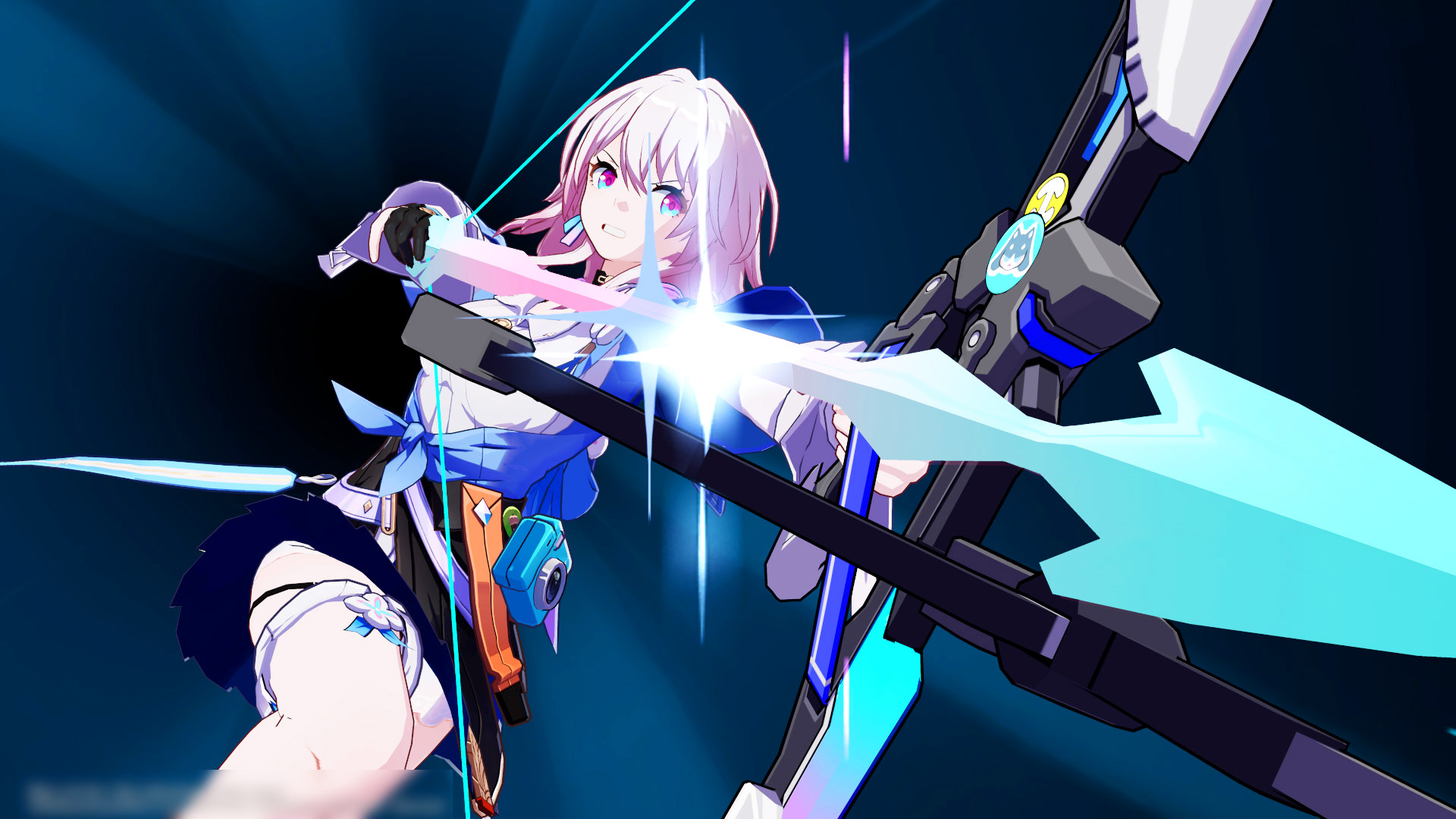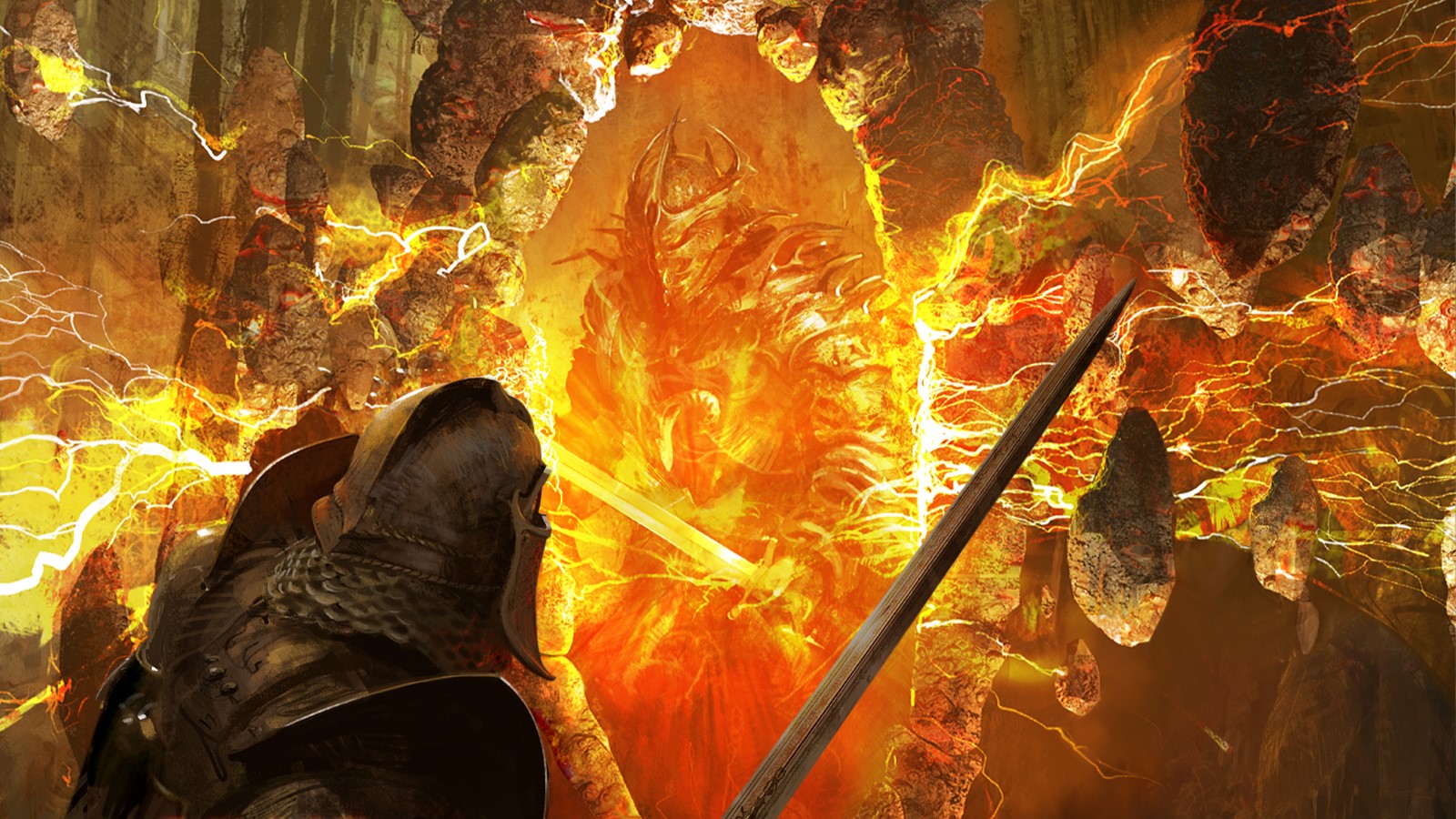
A true Genshin Impact successor with impeccable visual style and strategic depth.
(Image credit: Tyler C. / HoYoverse)
What is it? A sci-fi RPG with anime protagonists
Release date April 25, 2023
Expect to pay Free-to-play
Developer HoYoverse
Publisher HoYoverse
Reviewed on RTX 3080 Ti, i9 12900K, 32GB RAM
Steam Deck Unsupported
Link Official site
Honkai: Star Rail is supposed to be turn-based, but its battles move at the speed of a character action game. Plan your moves right, and your team will dash and dodge around the screen as if you’re in direct control. Sharp tactical decisions will earn you a swift victory, but the real reward is watching its dazzling, anime-inspired battles play out.
The camera tilts and shifts as characters strum guitars that electrify enemies, crack the screen with time-bending scythes, cry to their robot dads for protection, and dunk the camera underwater to cast heals. Every character glows with personality and their battlefield acrobatics are extraordinarily expressive.
In its most climactic battles, Star Rail’s combat looks a lot like Genshin Impact. Characters take control of the entire scene when they use their stylish ultimate abilities. But this sci-fi RPG’s characters aren’t just keybinds for their signature moves like they are in Genshin. Everyone gets their moment to be the linchpin for a particular encounter, which means it’s essential to build a varied roster of characters and to know exactly how they synergize.
Star Rail’s cast of anime protagonists fits its elastic tone, which fluctuates from the heroic optimism of a space opera, to the dark comedy of a Nier game, with a lot of Final Fantasy 14’s soap opera storytelling mixed in. Your main character, the Trailblazer, and her two crewmates travel to different planets and wade into the politics and problems of the locals. The steady pace of the plot and its surprisingly articulate writing help avoid the misery of having to sit through long stretches of worldbuilding like you’re forced to in Genshin. Here, that stuff is tucked away in text logs and item descriptions. Star Rail doesn’t waste your time, and it plays like a modern RPG—with some free-to-play gacha game caveats.
Ditching the open-world structure established in Genshin lets Star Rail focus on building a meaningful cast of side characters through quests and stray conversations. NPCs periodically send text messages asking for help or just to check in, each an opportunity to personify the Trailblazer in a much more playful and compelling way than the Traveler in Genshin. My Trailblazer sends emojis and spams question marks to her friends. She’s tired, confused, and doing her best—a truly resonant character for anyone trying to survive what it’s like to be alive and online in 2023.
Star Rail is legitimately funny too, routinely making fun of your decisions and giving you dialogue responses that shrug off the melodrama of the world’s catastrophic events—goofy responses or actions, like telling a violent sentient robot he has a nice haircut or taking a seat on a teleporting toilet. Star Rail’s writing is hyper aware of the tropes it deploys, but balances that with a genuine sincerity when it comes to its most important characters and themes.
Once you leave the space station in Star Rail’s intro, which acts as the hub for important characters and side quests later on, you’re dropped into Jarilo-VI, a frozen planet that shares the same problem as the Trailblazer. (Jarilo-VI is one of two planets available at launch, but, sort of like Genshin’s regions, more will be added over time.) Jarilo-VI was tricked by one of the universe’s gods and given a Stellaron, a seed of disaster that helps civilizations prosper before it mutates and curses them for eternity. The Trailblazer has one inside her, which makes her uniquely equipped to find out how to stop them.
You don’t spend a long time trekking through the snow before being escorted to the planet’s last living city, Belobog. On the surface, the city looks surprisingly prosperous despite being surrounded by a frozen wasteland. Heaters line the stone streets and citizens gather around a monument dedicated to the ancient people that made the place habitable. But toiling below the city is an entire society of miners keeping the lights on.
Star Rail doesn’t go full Final Fantasy 7 with its depiction of class disparity and anarchism in Jarilo-VI. It’s actually more soft on that aspect than I like, but the missions there spend a lot of time unearthing how the extreme precarity became an excuse for extreme control by the people in power. While the planet’s storyline doesn’t end on a radical solution to the problem, it suggests that Star Rail won’t have the kind of story where a magical hero fixes everything with her magical powers. You simply get the ball rolling. Jarilo-VI and the second planet—a bright, futuristic China with immortality problems—are distinct locations with casts of characters who are capable of handling their planet’s problems on their own.
(Image credit: Tyler C. / HoYoverse)
Chain reaction
Your role is to clean the place up so that change can take place. Enemies take on several forms, from humans to a legion of Evangelion-looking robots with destructive powers. In Belobog, these metal monsters patrol the sections plagued by the effects of the Stellaron. Exploring is like a limited version of Genshin’s third-person traversal: you sprint down streets and into caves containing chests, hacking minigames, and health pickups while avoiding or colliding with enemies. You can creep up on foes to see their list of elemental weaknesses and use one of your four characters’ techniques to start battles with an advantage, like a party-wide damage buff or a chance to freeze enemies in place from the start.
Star Rail accelerates the tactical strengths of the best turn-based RPGs to create an adaptable experience for all kinds of players.
Star Rail’s combat requires a mix of characters that match the elemental weaknesses of its enemies and have supportive abilities to mitigate incoming damage and debuffs. Every character has a basic attack, skill, passive, and an ultimate—tools to intercept the enemy’s advances. Attack with the correct element and you deplete a white bar that causes enemies to weakness break, or be exposed to increased damage and delay their next turn. Ideally, you want to starve the enemies of their actions by chaining abilities together. But you won’t always have the right elements and will have to contend with attacks that incapacitate, delay, and weaken your party’s moves.
I ran a party centered around Seele, a damage dealer with the unique ability to gain an extra turn when she kills an enemy. She pairs nicely with Bronya, a support who can grant an ally a free turn using her skill. When the elements aligned in my favor, I could fuel my devastatingly strong Seele with killing blows so she could chain enough attacks to charge up her powerful ultimate, which would lead to another killing blow. Other characters, like rockstar Serval, specialize in spreading periodic damage to weak enemies so the rest of your team can focus on stronger monsters.
You can brute force—and even auto-battle—fights against weak monsters and not worry about matching elements, but some difficult encounters force you to engage with the elemental system. Missions and repeatable encounters, like the Calyx challenges (like Genshin’s Ley Lines), funnel you items to increase your character’s level, their Light Cones (weapons), their Relics (artifacts), and their Traces (talents).
(Image credit: Tyler C. / HoYoverse)
Story encounters tend to be roadblocks if you don’t have a well-rounded roster. Underleveled characters, like in Genshin, can work in a pinch for their elemental affinity, but as you increase your Trailblazer Level, enemies hit hard and pull out unique mechanics. A boss in Jarilo-VI’s story summons a metal hand that steals one of your characters and traps them until you break them out. The boss’s constant, brutal attacks don’t give you the time to whittle away the hand’s health, forcing you to bring someone who can quickly weakness break it before your team is wiped out.
By emphasizing each character’s individual skills and the interactions between them, Star Rail distills what’s most satisfying about turn-based RPGs: tactical, team-based decisions. Over the course of the 30 hours I played, I rarely had to spam basic attacks to get back to the meaningful abilities—which is usually a sign that you’re misplaying. Instead, I always had an ultimate or skill available to puzzle my way through an encounter.
Star Rail accelerates the tactical strengths of the best turn-based RPGs to create an adaptable experience for all kinds of players. Combat encounters only last a few minutes, but the rapid exchange of potent attacks intensifies every second. Mistakes are felt immediately, which trains you to quickly adapt and experiment with different team compositions. Your decisions shape the fight, but instead of punishing you for being underleveled (within reason), you’re asked to come up with a creative solution using the tools you have. If Genshin is a shockingly expansive open-world live-service game, Star Rail is a shockingly clever permutation of modern turn-based RPGs, expertly designed to emulate the thrill of playing your cards right without having to spend 90 hours to get to the good parts.
(Image credit: Tyler C. / HoYoverse)
Cash in
The characters you have access to significantly impact how you approach fights and their individual levels can even determine whether or not you can attempt them in the first place. There are a handful of roadblocks in the story that send you back out into the world to earn more Trailblazer and character levels, and while these breaks don’t last long if you alternate between side quests and daily activities, they stall you from experiencing one of the most creative, modern RPGs I’ve played.
It’s a tonal chameleon that switches modes so deftly that it had me cheering it on.
Star Rail’s gacha systems are almost identical to those in Genshin. Instead of original resin as an energy system to limit your access to farmable activities, Star Rail has Trailblaze power. Your Trailblaze power replenishes every three hours, but purchasing premium currency to increase it will always be faster. And the drop rates for its most rare and powerful characters remain low; not terribly low, but low enough to take weeks of devoted grinding or your money.
None of Star Rail’s monetization systems are egregious, but the artificial complexity present in its various currencies and reward systems splinter what could be a smooth experience. It reminds me of having to grind dungeons to meet the level requirement for the next story quest in Final Fantasy 14. It’s just enough of a pain that someone would surely pay to make it go away, and of course, that is exactly where HoYoverse taunts you with its gacha and energy systems.
(Image credit: Tyler C. / HoYoverse)
Star Rail, at least in its initial state, doesn’t sacrifice its smart design by forcing you to engage with its monetization to fully satisfy. Its free cast of characters, stellar combat, and variety of side quests prevent it from feeling like an excuse to get into your wallet. A version of Star Rail untethered from these commercial intentions wouldn’t be all that different, but it sure would make it much easier to celebrate how fun it is to play.
Because when Star Rail hits, it hits. A climactic boss fight at the end of the first planet is a battle against a god in the middle of a snow storm where electric guitars wail and drums build. As she holds up a black vortex of cosmic energy and threatens your team, the music simmers in the background. The scene ends, her health bar reappears, and the song kicks back in with soaring vocals. All the strategy and complexities fade away and Star Rail gives you a stage for your team’s final act.
Star Rail’s unrestrained commitment to its characters, world, and systems, earns it the right to have a glorious anime battle set to a rock anthem. It’s a tonal chameleon that switches modes so deftly that it had me cheering it on. It’s alive and imaginative in a way the fantasy world of Genshin has never been able to pull off. Where it goes from here is a mystery, but its sheer creativity has me convinced it’s a ride worth taking.






